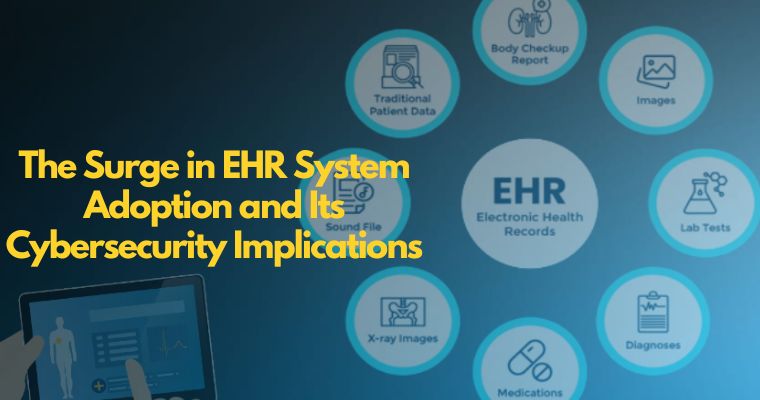Electronic Health Record (EHR) systems showcase how technology profoundly improves patient care. These systems offer a unified and comprehensive snapshot of a patient’s medical history, allowing for better diagnostics, more accurate treatments, and streamlined administrative processes.
However, as with all technological advancements, the adoption of EHRs comes with its own set of challenges, including safety and security concerns regarding patient records.
As medical records transition from paper files locked in cabinets to digital data stored on servers, they become susceptible to a myriad of cyber threats. The implications of such threats are far-reaching, not just compromising the privacy of millions, but potentially endangering lives.
Table of Contents
The Rise of EHR Systems
The digital revolution of the late 20th and early 21st centuries brought vital transformative changes in various sectors, and healthcare was no exception.
As other industries began to benefit from computerization, so too did hospitals, clinics, and medical practitioners see the potential in harnessing technology for improved patient care.
This led to the development of Electronic Health Record (EHR) systems, with pioneers like the Mayo Clinic in Rochester, Minnesota being one of the first major health systems to adopt an EHR in the 1960s.
Historically, patient records were maintained as physical documents, stored in towering file cabinets and shuffled from one department to another.
This process was time-consuming, prone to human error, and sometimes resulted in lost or misplaced records. EHR systems emerged as the solution, offering a more efficient, accurate, and streamlined method of maintaining patient information.
By the early 2000s, many developed countries shifted from paper to EHRs, often supported by government incentives
The last decade has witnessed an exponential surge in the adoption of Electronic Health Record (EHR) systems.
Fueled by a combination of government incentives, the promise of streamlined operations, and a push for digital transformation across industries, healthcare institutions globally have rapidly integrated EHR systems into their daily operations.
However, this rapid digital expansion has also broadened the attack surface for cyber adversaries, revealing vulnerabilities and giving rise to an increasing number of cybersecurity incidents.
The swift adoption of EHRs was significantly driven by the global shift towards telemedicine, further emphasized during the COVID-19 pandemic.
As clinics and hospitals adapted to remote consultations, the necessity for real-time, digital access to patient records became paramount. This mass digital migration, though essential, was executed hastily by many, often sidelining crucial cybersecurity protocols.
Cybersecurity Implications
Real-world examples underscore the vulnerabilities. For instance, in 2020, Universal Health Services (UHS), a major hospital chain in the U.S., fell victim to a ransomware attack.
This attack crippled its digital operations for days, forcing medical staff to revert to manual record-keeping and, in some instances, redirecting patients to other hospitals.
This incident not only revealed the dependency on digital systems, but also the profound risks associated with potential breaches.
Another illustrative example is the 2019 breach of the American Medical Collection Agency (AMCA), where unauthorized access exposed the data of nearly 25 million patients.
This breach not only compromised patient privacy but also showcased the domino effect in digital health ecosystems, affecting various clients of AMCA, including Quest Diagnostics and LabCorp.
These incidents are far from isolated. The accelerated migration to EHR systems, often without adequate security measures, has made the healthcare sector a lucrative target for cybercriminals.
The reasons are multifold: the sensitive nature of medical data makes it valuable, the interconnectedness of healthcare systems offers multiple entry points, and the often time-sensitive nature of medical operations makes institutions more likely to pay ransoms in the event of attacks.
While the recent mass adoption of EHRs promises improved healthcare efficiency and patient experience, it also necessitates a reevaluation of cybersecurity strategies.
It is evident that as EHR systems become ubiquitous, robust cybersecurity measures are not just an option but an imperative.
How to Cyber-Proof Your EHR Software?
Navigating the complex world of EHR software, healthcare institutions prioritize one unchanged principle: protecting patient data.
To ensure this, it’s essential to adopt core protective measures: robust encryption for data at rest and in transit, multifactor authentication, role-driven access controls, regular security training for staff, and encrypted backups both on-site and off-site.
Whether you’re considering a custom-built solution or off-the-shelf software, it’s crucial to implement robust security measures.
Custom-built EHR Software Solutions
Custom solutions offer healthcare institutions the allure of tailor-made flexibility. While these tailored systems address specific organizational needs, they come with their own set of maintenance responsibilities and potential integration hurdles.
To harness the full potential of such solutions, it’s vital to hire developers skilled in HIPAA-compliant EHR software development.
Secure coding practices, frequent risk evaluations, and timely software updates are essential to mitigate emerging threats and vulnerabilities.
Off-the-shelf EHR Software Solutions:
For those looking for plug-and-play solutions, off-the-shelf software is a more suitable choice. While being cost-effective and quick to deploy, these standardized systems may occasionally constrain deeper customization.
Their security effectiveness often reflects the vendor’s dedication to cybersecurity.
As a result, deep dives into vendor security practices, recognizing software adaptability limits, ensuring consistent updates, and advocating for third-party security audits become crucial steps in the adoption process.
Emphasizing these strategies, healthcare organizations can solidify their EHR defenses, ensuring patient data remains secure, accessible, and integral amidst our rapidly digitalizing era.
Best Practices for Enhancing EHR Cybersecurity
As cyber threats evolve, it’s vital that healthcare organizations adopt a proactive approach to safeguard their EHR systems.
Implementing a combination of technical measures, employee training, and regular maintenance can drastically reduce the risk of cyber threats. Let’s delve into some of the best practices for bolstering EHR cybersecurity:
1. Regular System Updates: Importance of Updating and Patching:
Like all software, EHR systems have their vulnerabilities. With cyberattackers refining their methods, software providers continuously release updates and patches to counteract these new threats.
Regularly updating your EHR system not only provides access to newer features but also bolsters protection against known vulnerabilities.
2. Employee Training:
Regular Cybersecurity Awareness Programs:
Employees are often the first line of defense in cybersecurity. An uninformed click on a malicious link can compromise the entire system. Thus, educating staff on the latest threats and safe online practices turns them from potential vulnerabilities into critical assets in cybersecurity.
Simulated Phishing Tests:
Phishing remains a leading method of cyber-attack. Simulated tests help gauge employee vulnerability. By running mock phishing campaigns, organizations can identify areas for training enhancement, ensuring staff can discern and sidestep real threats.
3. Access Control:
Role-based Access:
Limiting access to patient data based on job function ensures that information isn’t inadvertently shared or exposed. Role-based controls reduce the risk of internal breaches.
Multifactor Authentication:
With MFA, even if a malicious actor obtains a password, they’d need a second verification method, adding another security layer.
4. Network Security: Firewalls, VPNs, and Intrusion Detection Systems:
Network security is foundational. Firewalls control traffic based on security policies. VPNs encrypt internet traffic, and Intrusion Detection Systems alert to suspicious patterns.
5. Regular Backups:
Importance of Frequent and Secure Backups:
A recent backup can be a lifesaver in events like ransomware attacks or data corruption. Regular backups ensure system restoration with minimal data loss.
Best Practices in Backup Management:
Ensure backups are encrypted, stored both on-site (for rapid recovery) and off-site (to safeguard against physical threats). Test backups periodically and maintain a defined backup schedule.
Final Thoughts
While EHRs enhance patient care, streamline operations, and support real-time medical decisions, they also present significant cybersecurity challenges.
In the ongoing digital evolution of healthcare, intertwining innovation with strong cybersecurity is crucial. It not only fosters trust but also lays the foundation for superior patient care in today’s era.



